一:关于Nacos的思考
首先思考一个问题,Nacos作为配置中心,Nacos 客户端是怎么实时获取到 Nacos 服务端的最新数据?
其实客户端和服务端之间的数据交互,无外乎两种情况:
1.服务端推数据给客户端
2.客户端从服务端拉数据
zk作为配置中心,基于zk的watcher机制,配置发生变化通知客户端,Nacos也是同样的原理吗?
二:Nacos的源码解析
看看Nacos是如何获取服务端的最新数据
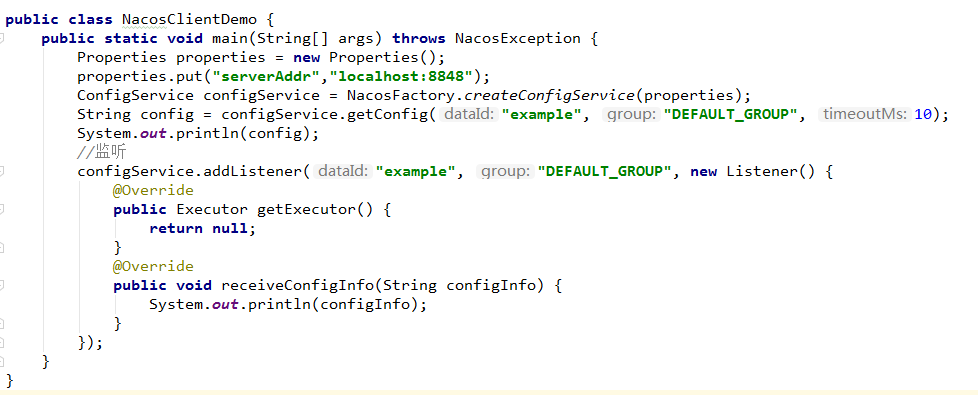
createConfigService的作用:通过反射创建NacosConfigService


public static ConfigService createConfigService(Properties properties) throws NacosException {
try {
Class<?> driverImplClass = Class.forName("com.alibaba.nacos.client.config.NacosConfigService");
Constructor constructor = driverImplClass.getConstructor(Properties.class);
ConfigService vendorImpl = (ConfigService) constructor.newInstance(properties);
return vendorImpl;
} catch (Throwable e) {
throw new NacosException(NacosException.CLIENT_INVALID_PARAM, e);
}
}
NacosConfigService的构造函数

new MetricsHttpAgent(new ServerHttpAgent(properties))作用:MetricsHttpAgent包装ServerHttpAgent(装饰器模式)为了做一些统计等功能。
agent.start()作用 : 监听服务器列表是否变化


public class MetricsHttpAgent implements HttpAgent {
private HttpAgent httpAgent;
public MetricsHttpAgent(HttpAgent httpAgent) {
this.httpAgent = httpAgent;
}
@Override
public void start() throws NacosException {
httpAgent.start();
}
@Override
public HttpResult httpGet(String path, List<String> headers, List<String> paramValues, String encoding, long readTimeoutMs) throws IOException {
Histogram.Timer timer = MetricsMonitor.getConfigRequestMonitor("GET", path, "NA");
HttpResult result = null;
try {
result = httpAgent.httpGet(path, headers, paramValues, encoding, readTimeoutMs);
} catch (IOException e) {
throw e;
} finally {
timer.observeDuration();
timer.close();
}
return result;
}
@Override
public HttpResult httpPost(String path, List<String> headers, List<String> paramValues, String encoding, long readTimeoutMs) throws IOException {
Histogram.Timer timer = MetricsMonitor.getConfigRequestMonitor("POST", path, "NA");
HttpResult result = null;
try {
result = httpAgent.httpPost(path, headers, paramValues, encoding, readTimeoutMs);
} catch (IOException e) {
throw e;
} finally {
timer.observeDuration();
timer.close();
}
return result;
}
@Override
public HttpResult httpDelete(String path, List<String> headers, List<String> paramValues, String encoding, long readTimeoutMs) throws IOException {
Histogram.Timer timer = MetricsMonitor.getConfigRequestMonitor("DELETE", path, "NA");
HttpResult result = null;
try {
result = httpAgent.httpDelete(path, headers, paramValues, encoding, readTimeoutMs);
} catch (IOException e) {
throw e;
} finally {
timer.observeDuration();
timer.close();
}
return result;
}
@Override
public String getName() {
return httpAgent.getName();
}
@Override
public String getNamespace() {
return httpAgent.getNamespace();
}
@Override
public String getTenant() {
return httpAgent.getTenant();
}
@Override
public String getEncode() {
return httpAgent.getEncode();
}
}
new ClientWorker(agent, configFilterChainManager, properties)的作用:线程池轮询服务器
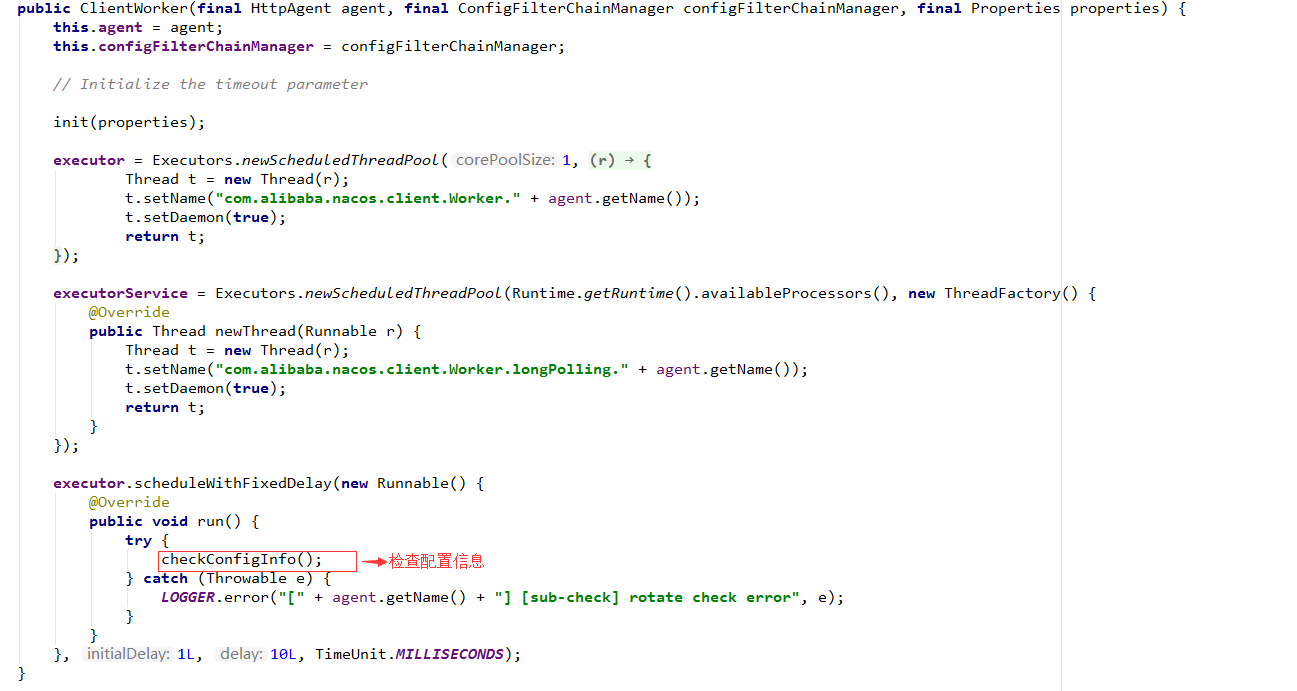

public ClientWorker(final HttpAgent agent, final ConfigFilterChainManager configFilterChainManager, final Properties properties) {
this.agent = agent;
this.configFilterChainManager = configFilterChainManager;
// Initialize the timeout parameter
init(properties);
executor = Executors.newScheduledThreadPool(1, new ThreadFactory() {
@Override
public Thread newThread(Runnable r) {
Thread t = new Thread(r);
t.setName("com.alibaba.nacos.client.Worker." + agent.getName());
t.setDaemon(true);
return t;
}
});
executorService = Executors.newScheduledThreadPool(Runtime.getRuntime().availableProcessors(), new ThreadFactory() {
@Override
public Thread newThread(Runnable r) {
Thread t = new Thread(r);
t.setName("com.alibaba.nacos.client.Worker.longPolling." + agent.getName());
t.setDaemon(true);
return t;
}
});
executor.scheduleWithFixedDelay(new Runnable() {
@Override
public void run() {
try {
checkConfigInfo();
} catch (Throwable e) {
LOGGER.error("[" + agent.getName() + "] [sub-check] rotate check error", e);
}
}
}, 1L, 10L, TimeUnit.MILLISECONDS);
}
checkConfigInfo作用:检查配置信息


public void checkConfigInfo() {
// 分任务
int listenerSize = cacheMap.get().size();
// 向上取整为批数
int longingTaskCount = (int) Math.ceil(listenerSize / ParamUtil.getPerTaskConfigSize());
if (longingTaskCount > currentLongingTaskCount) {
for (int i = (int) currentLongingTaskCount; i < longingTaskCount; i++) {
// 要判断任务是否在执行 这块需要好好想想。 任务列表现在是无序的。变化过程可能有问题
executorService.execute(new LongPollingRunnable(i));
}
currentLongingTaskCount = longingTaskCount;
}
}
LongPollingRunnable:run方法是一个长轮询服务端过程,大致分为四块部分
第一部分:检查本地配置相关

checkLocalConfig作用:判断本地配置是否存在,是否有变更,dataId=“example”和group=“DEFAULT_GROUP”在Windows环境下默认配置路径(C:UsersAdministrator acosconfigfixed-localhost_8848_nacosdataconfig-dataDEFAULT_GROUPexample)。
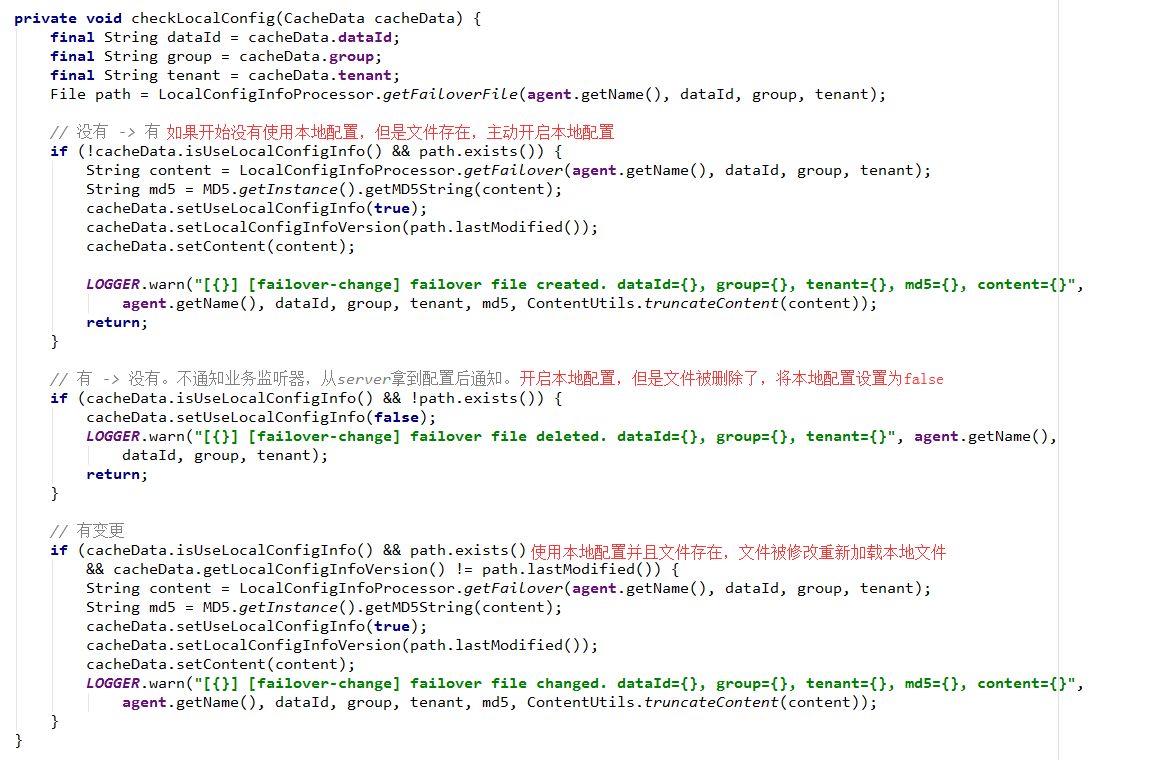

private void checkLocalConfig(CacheData cacheData) { final String dataId = cacheData.dataId; final String group = cacheData.group; final String tenant = cacheData.tenant; File path = LocalConfigInfoProcessor.getFailoverFile(agent.getName(), dataId, group, tenant); // 没有 -> 有 if (!cacheData.isUseLocalConfigInfo() && path.exists()) { String content = LocalConfigInfoProcessor.getFailover(agent.getName(), dataId, group, tenant); String md5 = MD5.getInstance().getMD5String(content); cacheData.setUseLocalConfigInfo(true); cacheData.setLocalConfigInfoVersion(path.lastModified()); cacheData.setContent(content); LOGGER.warn("[{}] [failover-change] failover file created. dataId={}, group={}, tenant={}, md5={}, content={}", agent.getName(), dataId, group, tenant, md5, ContentUtils.truncateContent(content)); return; } // 有 -> 没有。不通知业务监听器,从server拿到配置后通知。 if (cacheData.isUseLocalConfigInfo() && !path.exists()) { cacheData.setUseLocalConfigInfo(false); LOGGER.warn("[{}] [failover-change] failover file deleted. dataId={}, group={}, tenant={}", agent.getName(), dataId, group, tenant); return; } // 有变更 if (cacheData.isUseLocalConfigInfo() && path.exists() && cacheData.getLocalConfigInfoVersion() != path.lastModified()) { String content = LocalConfigInfoProcessor.getFailover(agent.getName(), dataId, group, tenant); String md5 = MD5.getInstance().getMD5String(content); cacheData.setUseLocalConfigInfo(true); cacheData.setLocalConfigInfoVersion(path.lastModified()); cacheData.setContent(content); LOGGER.warn("[{}] [failover-change] failover file changed. dataId={}, group={}, tenant={}, md5={}, content={}", agent.getName(), dataId, group, tenant, md5, ContentUtils.truncateContent(content)); } }
第二部分:检查server端的变更

第三部分:如果server端有变更,更新CacheData的content
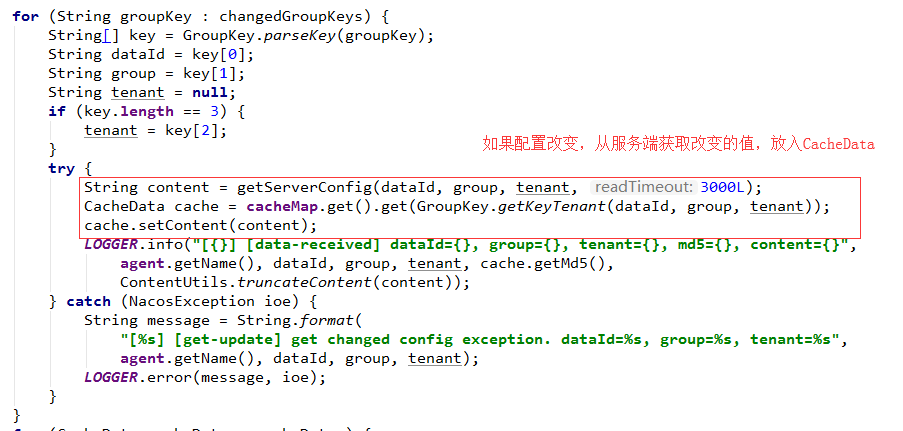
第四部分:检查md5的值是否改变,即配置是否改变,选择唤醒listener回调

checkListenerMd5作用:检查CacheData的md5和wrap(listener的包装器)的md5是否一致,如果不一致唤醒回调

sageNotifyListener作用 : 触发listener的回调函数
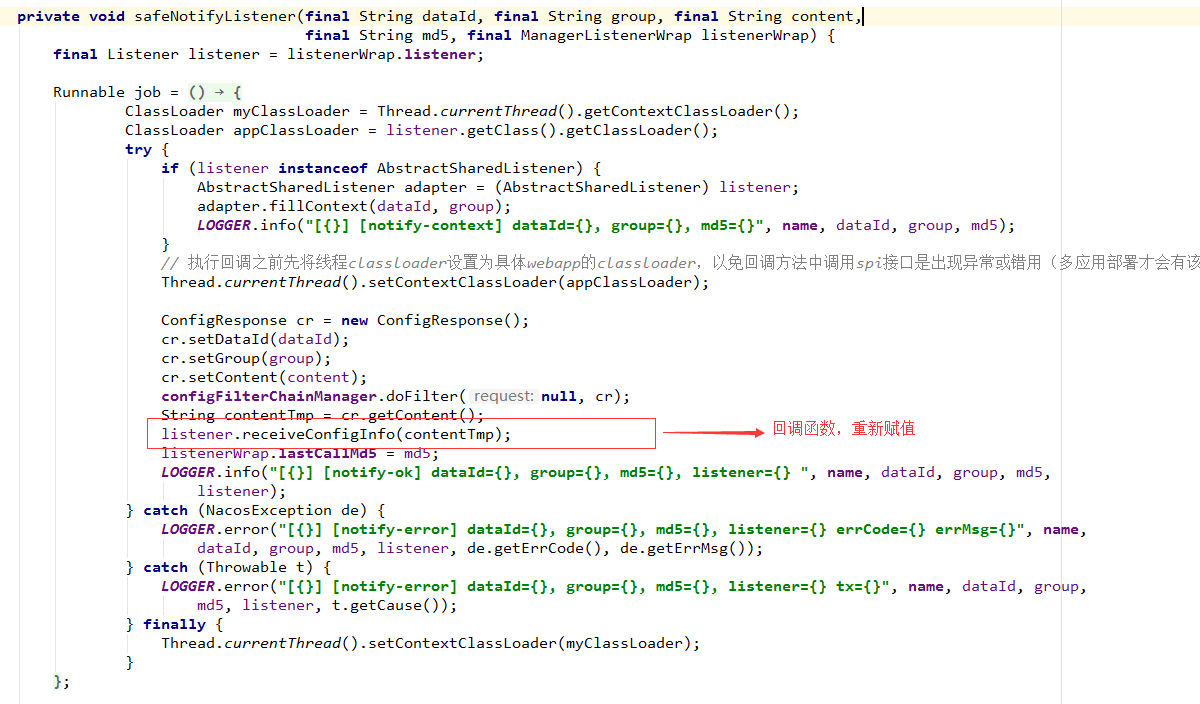
配置中心的完整流程已经分析完毕了,可以发现,Nacos 并不是通过推的方式将服务端最新的配置信息发送给客户端的,而是客户端维护了一个长轮询的任务,定时去拉取发生变更的配置信息,然后将最新的数据推送给 Listener 的持有者。
三:Nacos配置中心总结归纳
1. 关闭Nacos服务端,删除本地配置,启动测试类,依然能获取配置信息,为什么呢?
跟踪代码 String config = configService.getConfig("example", "DEFAULT_GROUP", 10)

当前环境下快照地址为:C:UsersAdministrator acosconfigfixed-localhost_8848_nacossnapshotDEFAULT_GROUPexample
2.客户端拉取服务端的数据与服务端推送数据给客户端相比,优势在哪呢,为什么 Nacos 不设计成主动推送数据,而是要客户端去拉取呢?
如果用推的方式,服务端需要维持与客户端的长连接,这样的话需要耗费大量的资源,并且还需要考虑连接的有效性,例如需要通过心跳来维持两者之间的连接。而用拉的方式,客户端只需要通过一个无状态的 http 请求即可获取到服务端的数据。
3. Nacos实现配置中心的原理?
客户端是通过一个定时任务来检查自己监听的配置项的数据,一旦本地配置或者服务端的数据发生变化时,客户端将会获取到最新的数据(跟踪checkUpdateDataIds方法可以明白),优先本地配置,并将最新的数据保存在一个 CacheData 对象中,然后会重新计算 CacheData 的 md5 属性的值,此时就会对该 CacheData 所绑定的 Listener 触发 receiveConfigInfo 回调。考虑到服务端故障的问题,客户端将最新数据获取后会保存在本地的 snapshot 文件中。
上述为本人阅读源码的理解,可能存在误差。
